
A finger is a prominent digit on the forelimbs of most tetrapod vertebrate animals, especially those with prehensile extremities such as humans and other primates. Most tetrapods have five digits (pentadactyly), and short digits are typically referred to as toes, while those that are notably elongated are called fingers. In humans, the fingers are flexibly articulated and opposable, serving as an important organ of tactile sensation and fine movements, which are crucial to the dexterity of the hands and the ability to grasp and manipulate objects.
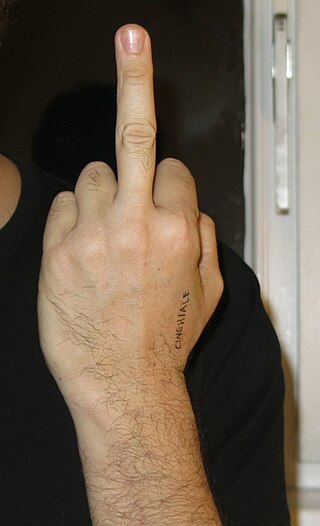
In Western culture, "the finger", or the middle finger is an obscene hand gesture. The gesture communicates moderate to extreme contempt, and is roughly equivalent in meaning to "fuck you", "fuck me", "shove it up your ass/arse", "up yours", or "go fuck yourself". It is performed by showing the back of a hand that has only the middle finger extended upwards, though in some locales, the thumb is extended. Extending the finger is considered a symbol of contempt in several cultures, especially in the Western world. Many cultures use similar gestures to display their disrespect, although others use it to express pointing without intentional disrespect. The gesture is usually used to express contempt but can also be used humorously or playfully.
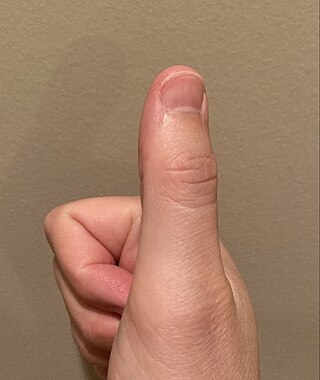
The thumb is the first digit of the hand, next to the index finger. When a person is standing in the medical anatomical position, the thumb is the outermost digit. The Medical Latin English noun for thumb is pollex, and the corresponding adjective for thumb is pollical.
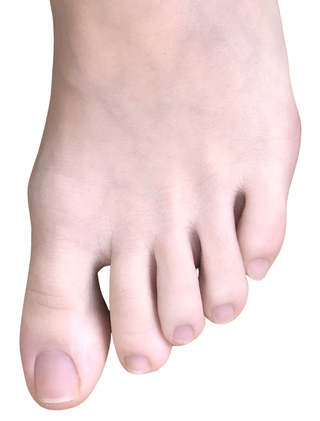
Toes are the digits of the foot of a tetrapod. Animal species such as cats that walk on their toes are described as being digitigrade. Humans, and other animals that walk on the soles of their feet, are described as being plantigrade; unguligrade animals are those that walk on hooves at the tips of their toes.

The middle finger, long finger, second finger, third finger, toll finger or tall man is the third digit of the human hand, located between the index finger and the ring finger. It is typically the longest digit. In anatomy, it is also called the third finger, digitus medius, digitus tertius or digitus III.

The upper limbs or upper extremities are the forelimbs of an upright-postured tetrapod vertebrate, extending from the scapulae and clavicles down to and including the digits, including all the musculatures and ligaments involved with the shoulder, elbow, wrist and knuckle joints. In humans, each upper limb is divided into the arm, forearm and hand, and is primarily used for climbing, lifting and manipulating objects.
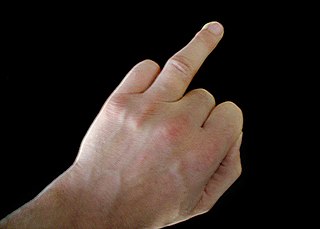
The ring finger, third finger, fourth finger, leech finger, or annulary is the fourth digit of the human hand, located between the middle finger and the little finger.
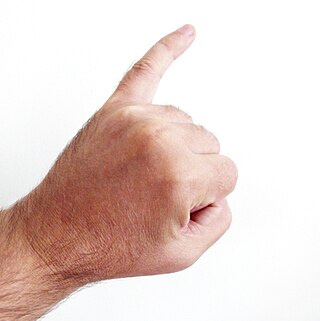
The little finger or pinkie, also known as the baby finger, fifth digit, or pinky finger, is the most ulnar and smallest digit of the human hand, and next to the ring finger.

In terrestrial vertebrates, digitigrade locomotion is walking or running on the toes. A digitigrade animal is one that stands or walks with its toes (phalanges) on the ground, and the rest of its foot lifted. Digitigrades include birds, cats, dogs, and many other mammals, but not plantigrades or unguligrades. Digitigrades generally move more quickly than other animals.

A span is the distance measured by a human hand, from the tip of the thumb to the tip of the little finger. In ancient times, a span was considered to be half a cubit. Sometimes the distinction is made between the great span or full span and little span or short span.

Chinese number gestures are a method to signify the natural numbers one through ten using one hand. This method may have been developed to bridge the many varieties of Chinese—for example, the numbers 4 and 10 are hard to distinguish in some dialects. Some suggest that it was also used by business people during bargaining when they wish for more privacy in a public place. These gestures are fully integrated into Chinese Sign Language.

The OK gesture or OK sign or ring gesture is performed by joining the thumb and index finger in a circle, and holding the other fingers straight or relaxed away from the palm. Commonly used by scuba divers, it signifies "I am OK" or "Are you OK?" when underwater. In most English-speaking countries it denotes approval, agreement, and that all is well or "okay". In other contexts or cultures, similar gestures may have different meanings including those that are negative, offensive, financial, numerical, devotional, political, or purely linguistic.
A taunt is a battle cry, sarcastic remark, gesture, or insult intended to demoralize or antagonize the recipient. Taunting can exist as a form of social competition to gain control of the target's cultural capital. In sociological theory, the control of the three social capitals is used to produce an advantage in the social hierarchy, so as to enforce one's own position in relation to others. Taunting is committed by either directly or indirectly encouraging others to taunt the target. The target may give a response in kind to maintain status, as in fighting words and trash-talk.

The hamsa, also known as the hand ofFatima, is a palm-shaped amulet popular throughout North Africa and in the Middle East and commonly used in jewellery and wall hangings. Depicting the open hand, an image recognized and used as a sign of protection in many times throughout history, the hamsa has been traditionally believed to provide defense against the evil eye.

Finger-counting, also known as dactylonomy, is the act of counting using one's fingers. There are multiple different systems used across time and between cultures, though many of these have seen a decline in use because of the spread of Arabic numerals.
A bow draw in archery is the method or technique of pulling back the bowstring to store energy for the bow to shoot an arrow. The most common method in modern target archery is the Mediterranean draw, which has long been the usual method in European archery. Other methods include the pinch draw and the Mongolian or "thumb" draw. In traditional archery practice outside Western Europe the variations of the thumb draw are by far the most dominant draw types, with the Mediterranean draw restricted to the Olympic style of target archery.

A hand is a prehensile, multi-fingered appendage located at the end of the forearm or forelimb of primates such as humans, chimpanzees, monkeys, and lemurs. A few other vertebrates such as the koala are often described as having "hands" instead of paws on their front limbs. The raccoon is usually described as having "hands" though opposable thumbs are lacking.

Pointing is a gesture specifying a direction from a person's body, usually indicating a location, person, event, thing or idea. It typically is formed by extending the arm, hand, and index finger, although it may be functionally similar to other hand gestures. Types of pointing may be subdivided according to the intention of the person, as well as by the linguistic function it serves.

Canonical digits, also referred to as liturgical digits, are a posture or bodily attitude of prayer used during the celebration of the rite of the Holy Mass. This gesture is performed by any Catholic priest after consecration and before ablutions, standing and joining his thumb and index finger in a circle, and holding the other fingers straight away from the palm.






















